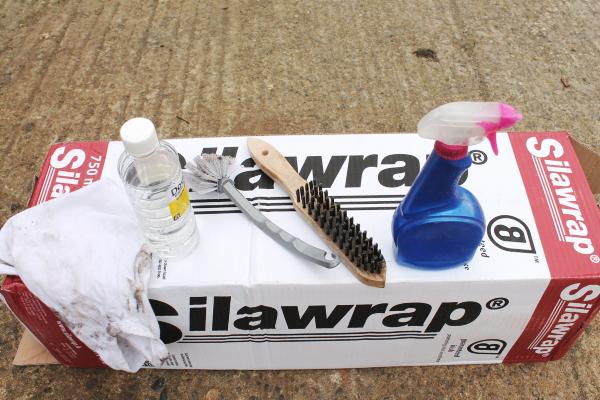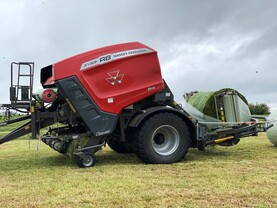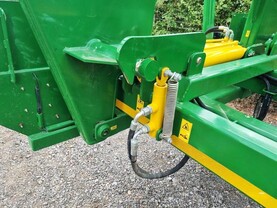For many, wrapped baled silage and haylage is one of the handiest ways of producing good-quality silage. It is crucial that the wrap is applied correctly both from a quality of silage perspective and a cost perspective.
The wrapper itself will generally be serviced and maintained to some degree, with regular greasing, cleaning and checks. More often than not, there is not enough care put into setting up and maintaining the plastic wrapping elements of a wrapper both before and during a season’s operation.
The Irish Farmers Journal spoke to Maurice Keady, who is sales manager for Irish bale film manufacturer Silawrap, to get some advice. Maurice looks after the northern half of Ireland plus a chunk of Britain while his colleague Pat O’Brien, also a sales manager, looks after the southern half of Ireland and another chunk of Britain.
Silawrap has been manufactured in Gorey, Co Wexford, since 1996. According to the firm, in excess of six million rolls have been sold in Ireland, Britain, mainland Europe, Australia and New Zealand. Maurice has been with the company since 1999 so is well positioned to offer users some practical advice on correctly setting up and maintaining a wrapper to apply plastic correctly.
We visited the farm of Bartley Holden, Co Kilkenny, where Maurice used Bartley’s Tanco 580J trailed wrapper to demonstrate how to get the best out of a roll of Silawrap. He told us how to set up the wrapper to apply the correct number of layers over the entire bale.
Roller cleaning
The pre-stretch roller mechanism stretches the plastic by 70% before it is applied onto the bales.
Tack is the glue on the film and this builds up on the rollers, especially in hot weather, according to Maurice. If there is too much tack on the rollers, the plastic slips and is not stretched as much as it should be.
The dew in the evening makes it worse, says Maurice, and it reduces stretch typically from 70% back to 50%. The farmer will then have a lower bale count per roll of plastic film.
How do you know when or how often to clean the rollers? If your hand sticks to the roller or rollers then Maurice advises cleaning them with white spirits.
Similarly, if there are tack and dirt lines at the top and bottom of the rollers then they need cleaning. Heavy grime requires the assistance of a wire brush to clean.
Also notable when the plastic slips is that the plastic film is wrinkly as it is applied onto the bale. His advice is shown through the photographs on this and the following pages.
Greasing the pre-stretch gears
The pre-stretch rollers are geared to each other to provide the 70% stretch required before the plastic is applied onto the bale. In general, most manufacturers use gears like those pictured on P10 to provide the difference in roller speeds to stretch the plastic film. Others do use plastic gears or even chain and sprocket arrangements but this geared mechanism is the more likely system to be found here. In Maurice’s experience, 90% of wrappers have these types of gears.
To stretch the film by 70% there is considerable pressure on the gears and they do require regular greasing. Individual manufacturers will provide their own guidelines but Maurice advises greasing them every 500 to 1,000 bales. Failure to grease the gears will cause them to run dry and cause problems with film stretch, usually over-stretching the film and, of course, wearing out the gears.
To gain access to the gear set on the top of the dispenser unit requires the cover on top to be removed. This may be held in place by small bolts, clips or screws – be careful not to lose them.
Number of wraps
A minimum of four layers of film should be applied to all parts of the bale. Six layers should be applied if grass dry matter is 35% or greater.
As part of regular maintenance and checks, especially if wrapping bales from different balers with slightly different diameters, it is very important to ensure that four layers of film are applied over the entire bale. Two or three layers on places could result in the bale bursting when being handled or stacked while also affecting the silage quality if not split.
Maurice demonstrates this by wrapping a bale of straw on Bartley’s wrapper. Setting the wrapper to seven revolutions demonstrated two things. The first is that it would require a further two revolutions to provide a full two layers of coverage, 18 in total to cover the entire bale with four layers.
The second thing it demonstrated was that the dispenser was set too high on the wrapper and was not applying the film across the middle of the wrapper. Setting it to the correct height allowed the bale to be completely covered with two layers on eight revolutions of the bale and not nine as before (eighteen for four layers). One turn saved with the bale correctly wrapped represents almost two extra bales per roll of film.
Correct settings are not just important for good quality silage but also when it comes to managing silage making costs.
Belt sag
Another important adjustment to keep both the bale turning correctly and the film applied in the correct position is the adjustment of belt sag. Turntable designs differ from one manufacturer to another but the vast majority use either a set of belts or one full-width belt. The belts are geared to provide a minimum 50% film overlap on the bale
Maurice points out that a machine wrapping 10,000 bales per year has had in the region of 7,500t of silage dumped on its belts. After four or five years of this, the belts will certainly need tensioning to bring them back up. The film dispenser must be aligned with it to compensate for the sag.
Maurice also advises tightening the belts but not so much as to cause the bale to fall off while being wrapped. After tensioning, he would advise to wrap slowly to see how the bale rotates in its newly elevated position. Tensioning the belts is done on the non-drive rollers, where it does not upset or interfere with the drive rollers, chain drive or drive mechanism.
The handler and rust
One very important and often neglected piece of maintenance required is to the bale handler, as Maurice pointed out. Rust on the handler is like sandpaper and will leave pinholes where the handler comes in contact with the plastic.
“You have to remember that there is a bale weighing approximately three-quarters of a tonne bouncing around on the handler. Rust will cause pin holes that you will not see unless you put the plastic up to the light,” explains Maurice.
Other ‘blemishes’ on the handler where it comes into contact with the wrapped bale need to be dealt with before it handles any wrapped bales and causes expensive silage spoilage.
Silawrap
For more useful advice, tips and videos, check out www.silawrap.ie. Alternatively, you can contact Maurice Keady, sales manager for the northern half of the country, on 086 2887089 or maurice.keady@itwstretch.com. In the southern half of the country, contact Pat O’Brien on 086 3821589 or patrick.obrien@itwstretch.com






 This is a subscriber-only article
This is a subscriber-only article

























SHARING OPTIONS: